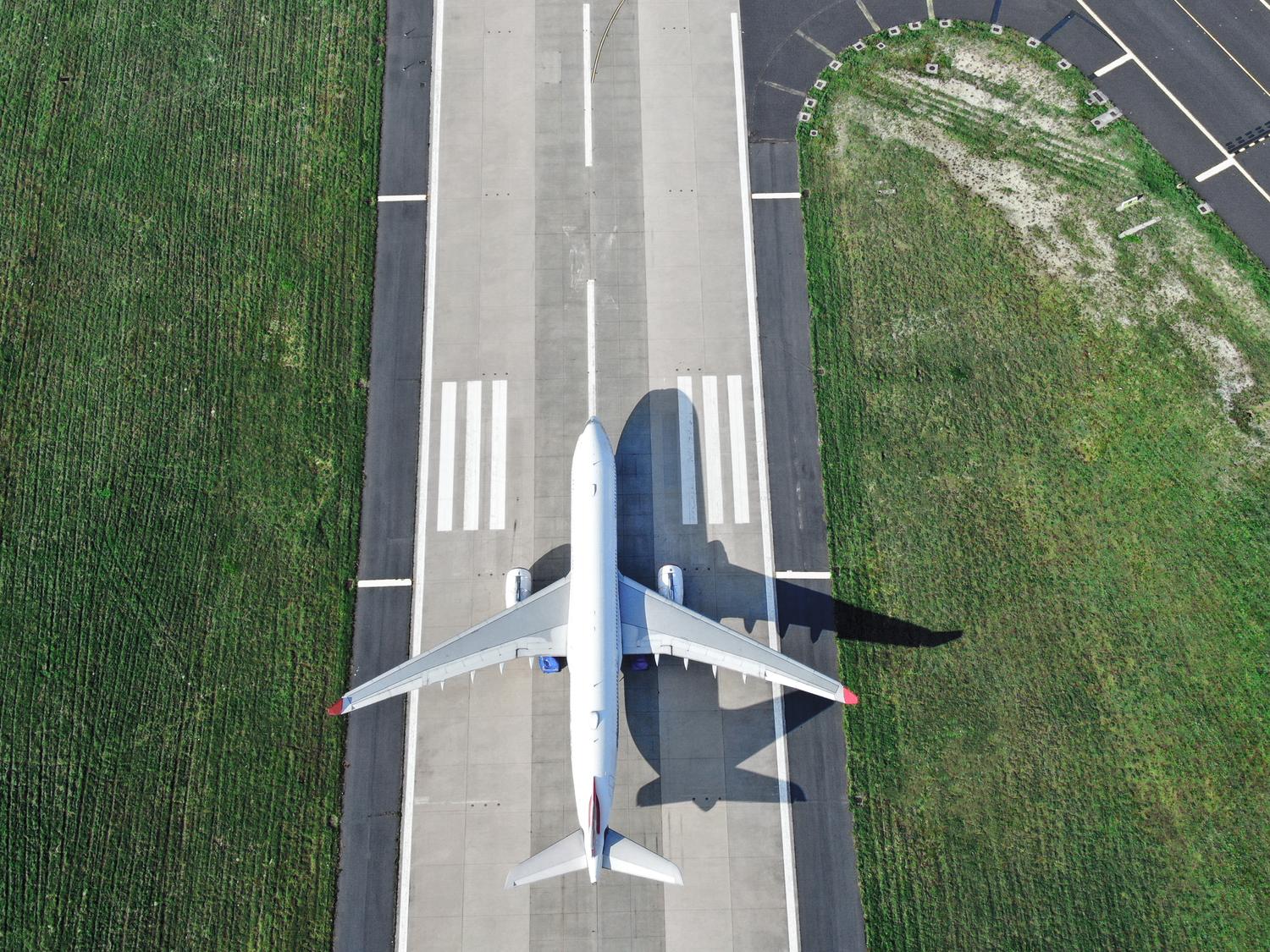
Aviation
7 minute read
Can sustainability ambitions keep pace with the post-pandemic air travel bounce back?
When the Covid-19 lockdowns were announced in early 2020, air passenger traffic fell by 93% almost overnight. Today, the industry has largely recovered and is forecast to continue growing. Since the pandemic, global sustainability ambitions have also significantly grown. Can these two trends be compatible or, in other words, can air travel ever be sustainable?
Online meetings revolutionized the way we conduct our business and significantly reduced our need to travel during the pandemic, while, for a time, leisure travel simply stopped being a thing. However, since the restrictions were lifted and we have been free to travel again, demand for air travel has steadily grown. Leisure air travel is now on the cusp of reaching pre-2019 levels, with corporate flights hot on its heels. While China and the Asia-Pacific region are driving this recovery, global passenger air travel as a whole is expected to increase by 3.6% annually, doubling by the middle of the century. Meanwhile, the aviation industry has broadly committed to Fly Net Zero by 2050.
“Sustainability ambitions have been rising alongside the awareness of society’s impact on the planet, and the role aviation plays in this,” says Susanne Bouma, Head of Partnerships and Programs at Neste’s Renewable Aviation business unit. “This likely accelerated as a direct result of the pandemic when we didn’t fly.”
So is it possible for the aviation industry to continue growing while also becoming more environmentally aware and more sustainable?
Sustainable aviation fuel: the poster kid of sustainable aviation today
Aviation is responsible for 2-3% of global greenhouse gas (GHG) emissions, but, given its growth trajectory, its climate impact could increase to more than 20% when considering how much faster other sectors are decarbonizing.
From experimentation with blended-wing airframes and ambitions for hydrogen-powered zero-carbon-emissions aircraft[LM1] , to technology and partnerships that make more sustainable aviation available to businesses at the point of booking, there is a hive of activity and initiatives to make sustainable aviation a reality.“I am excited to see so many businesses jumping on the opportunity to make mobility more sustainable with, for example, electric aircraft,” Bouma says. “However, as much as these innovations are very exciting and capture headlines, most are probably still decades from reaching scale. New technologies like shark-skin fuselages can indeed improve efficiency, but they won’t be enough on their own to meet aviation’s net-zero target by 2050. We know we need to scale sustainable aviation fuel as a solution today, while working on other solutions alongside it.”
Indeed, with the climate urgency upon us, solutions to make aviation more sustainable are needed now.
The main benefits of sustainable aviation fuel (SAF) are that – compared with conventional jet fuel – it can reduce GHG emissions by more than 80% over the fuel’s lifecycle, and it can be used in existing aircraft with no modification.With its potential to dramatically reduce aviation GHG emissions, demand for SAF has grown rapidly over the last few years. Production is also growing fast - while there is still a long way to go to scale production up to the level that will be needed, the pace of change is encouraging. According to IATA, SAF could contribute around 65% of the reduction in emissions needed by aviation to reach net-zero by 2050, with a mix of other solutions addressing the remaining 35%.
More sustainable aviation: the role of governments and regulations
Governments can play a crucial role in accelerating aviation’s carbon transition. Many are now laying out their strategies for more sustainable aviation, including introducing regulatory frameworks to support the transition to SAF.
In the US, for example, the 2022 Inflation Reduction Act promotes production of SAF by introducing a dual-phase incentive consisting of the Sustainable Aviation Fuel tax credit and the Clean Fuel Production credit. These provisions offer progressive backing for SAF production over the next five years – with a target set by President Biden to produce eight million tons of SAF domestically by 2030.The European Union has chosen a different approach to SAF. By adopting the ReFuelEU Aviation Regulation as part of the EU Green Deal’s ‘Fit for 55’ policy package, SAF suppliers will provide a progressively increasing portion of SAF at EU airports: 2% by 2025 and 70% by 2050.
“We are pleased to see that SAF mandates in the EU are becoming a reality, but we should not rely on mandates alone to increase SAF uptake,” cautions Bouma, highlighting the essential role of businesses and consumers in driving up uptake. “Achieving net-zero ambitions in aviation in the face of an upward trend in passenger numbers will not be a simple task, and it will require participation and commitment from us all. As well as regulation, we need consumers to be more aware of the impact of their trip, to understand the alternatives, and to demand more sustainable options. We also need suppliers like online travel agencies (OTAs) and traditional travel agents to include sustainability as an integral part of their products, not just as a ‘nice to have’ because we know this doesn’t work.”
Conversions in booking flows that require consumers to tick a box to opt-in for sustainability measures, for example, are very low at around 1%. “Asking consumers to opt-out instead is far more effective,” Bouma explains, “but it requires leadership and courage to make this change.”
Shared ambition: more sustainable businesses and more sustainable aviation
The pandemic revealed a new way of working and reduced the need to travel. Meanwhile, the requirements for businesses to become more sustainable in their strategies and operations have since grown, and companies also have to disclose their carbon footprint.“The easiest way to make aviation more sustainable is of course to fly less,” says Chris Truss, Global Sustainability Director for corporate travel management company Reed & Mackay. “However, many of our corporate clients want to reintroduce travel to the level it was before the pandemic, and they see SAF as a route to achieving their sustainability and ESG targets.”
Reed & Mackay’s clients often have set science-based reduction targets that they have to adhere to in relation to reducing the corporate travel activity of their business. “Having a relationship with a company like Neste allows them greater flexibility in meeting these targets,” Truss adds. “Should they exceed a quota, for example, they can then ensure more of their future travel commitments contain a SAF element.”The ESG element is a big cog in the wheel of the aviation sector’s transformation over the next decades. “This is one of the top three discussion items for our clients,” Truss says. “Much of my time is spent talking to them about how we can help them maximize their ESG credentials. This could mean anything from flying premium economy instead of business to only flying half as much and conducting other meetings online.”
On our way to net-zero aviation
While the challenge of making aviation more sustainable is getting greater with the increasing demand for air travel, it is clear that the appetite and ambitions for sustainability are also growing, driving a collaborative change towards net-zero emissions.
Bouma is confident that such difficult transformations are possible, like history has shown us in other sectors, and that we are well on our way: “The first electric vehicles were exclusive and very expensive but, by adopting a systematic approach including incentives and regulation to boost consumer demand, we have seen a dramatic transformation across the EV landscape. I believe we can do the same for aviation if we cooperate and embrace the solutions we already have.”
Credits: Liam McCann, a freelance writer and sub-editor for The Daily Telegraph, and has written dozens of articles on sustainability in the automotive and transport sectors in particular.





